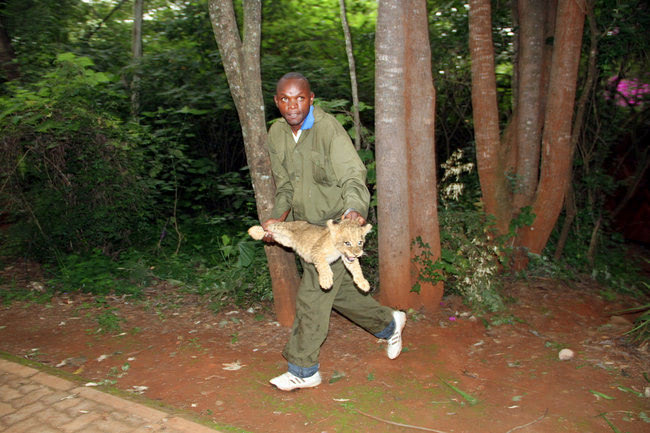Foxes, coyotes, bobcats, jackals, and dozens of other generalist predators have successfully adapted to suburbia, following their prey to where the grass is green and the landscaping is tasty. At their worst, these mid-sized species will knock over a few garbage cans and make a meal of Fluffy. In Kenya, however, suburban homeowners are now facing lions, animals that exclusively specialize in killing large prey. Too bad humans fit the definition of "large".
The situation in Nairobi is particularly tense. The wooded suburbs of Nairobi, a city of 3 million, border the 116 square kilometer Nairobi National Park. As lions are fiercely territorial, any weaker, subordinate cats are pushed out of prime habitat in the park and into the 'burbs. Female lions in particular may seek the relative shelter of suburbia to protect their cubs from aggressive males. In a recent article at the New York Times, Stephanie Dloniak describes one female who moved cubs in her backyard, and had to be darted and removed by animal control. The lioness got off easy. According to biologist Craig Packer, "Usually, urban carnivores are encountered as road kills.”

As cities and towns crowd up to the edges of the wilderness, human-animal conflicts are intensifying. Encounters with large, wild animals in civilized spaces usually follow the same script. We are fascinated (or frightened) to find a primordial beast in our backyard, so far removed from its "appropriate" context in a national park or nature documentary. Then, we call the authorities, and the interloper is sedated and relocated, or euthanized. Animals that are lucky enough to be relocated may not be so fortunate after all: Long-term residents with established territories may bully or kill newcomers from their own species.
It's a lose-lose situation for the animal, and it may be a losing situation for us. We share the world with 10 million other species, and yet our daily interactions with wild animals are limited to sidestepping pigeons or laying out poison for rats. It's no stretch to say that interactions with non-human minds are a valuable way to sharpen our sense of empathy, and perhaps even spirituality. As Jonathan Jones argues in The Sixth Extinction, for most of human existence wild animals embodied "the power of the cosmos and the mystery of existence". Maybe they still do.

Is there is a way for the ever-growing suburbs to encompass the wilderness, or for the wilderness to encompass the suburbs? As with Dloniak's article, the discussion usually turns to ways to better fence in the wilderness. For our safety and theirs, we must maintain the inflexible boundaries between the "natural" and the "unnatural". Even Animal Architecture, an organization dedicated to designing urban habitat for animals, has not tackled any creature larger or more dangerous than a sheep. This lack of imagination leaves us wondering if it's possible to design human spaces that are not just friendly for birds and bees, but for lions, tigers and bears. Under the paving stones, the Serengeti!
Story and images via the New York Times. Image of a mountain lion from Animal Planet.

Share your thoughts and join the technology debate!
Be the first to comment